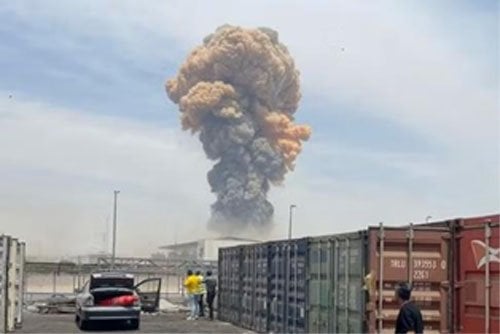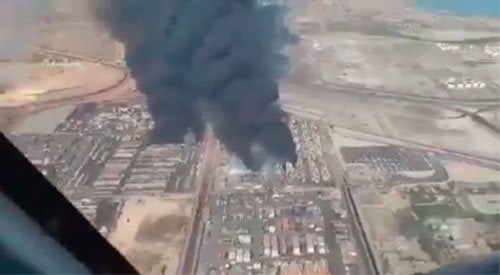Iran Steps Up Imports of Chinese Rocket Fuel Material

Iran appears to have accelerated the import of sodium perchlorate, the primary material used to manufacture ammonium perchlorate, which in turn makes up 70 percent of the standard fuel load of most of Iran’s solid-fueled ballistic missiles.
Before the 12-Day War, The Maritime Executive tracked the progress of two Islamic Republic of Iran Shipping Lines (IRISL) cargo ships, the MVs Golbon and Jairan, as they shipped a total of 58 containers of sodium perchlorate from the port of loading in Shanghai to Bandar Abbas. These two consignments brought in sufficient sodium perchlorate, probably about 1,000 tons, to fuel 240 missiles. Both ships had unloaded their consignments by the end of March into the Shahid Rajaei container park in the Bandar Abbas Commercial Port, and these are believed to have been the source of the explosion that devastated the port area on April 26.
In the pellet form it is being shipped in, sodium perchlorate is classified in the United States as a hazardous product, with explosive risks, and the fumes from which can cause breathing difficulties and kidney failure. Besides being the feedstock for ammonium perchlorate, it can also be used as an oxidizing agent in engraving processes and in the manufacture of livestock fattening agents. But as a dual-use product, and specifically because it is being conveyed by IRISL, the shipment should fall under the provisions of UN Security Council Resolution 1929, which cautions states to be aware of IRISL’s sanctions-breaking activities and its role in supporting Iran’s missile development, manufacture, and maintenance activities. These sanctions have been strengthened since snap-back sanctions were re-imposed by the UN Security Council on September 28.
Post the safe return of MVs Golbon and Jairan, the U.S. Treasury announced on April 29 that it had sanctioned an additional six companies and six individuals based in Iran and China for their roles in the network procuring ballistic missile propellant ingredients on behalf of the IRGC. Besides those sanctioned in Iran, five Chinese companies based in Hunan and Shandong Provinces involved in the manufacture of dual-use chemicals have been sanctioned: Yanling Chuanxing Chemical, Dongying Weiaien Chemical, China Chlorate Tech, Shenzhen Amor Logistics, and Yanling Lingfeng Chlorate.

The explosion at Bandar Abbas Commercial Port on April 26 (Tasnim News Agency - CC by 4.0)
When MVs Golbon and Jairan left Shanghai, The Wall Street Journal (WSJ) noted that a further 185 20-foot containers of sodium perchlorate had been ordered by Iran, sufficient to fuel a further 800 ballistic missiles. At the time, The Maritime Executive spotted that three medium-sized container ships owned by IRISL were waiting to load in the CMK/K14 anchorage off Shanghai, namely MVs Barzin (IMO 9820269), Rayen (IMO 9820245), and Behta (IMO 9349590), all previously sanctioned.
New information published by CNN and based on unnamed European intelligence sources, named four ships, all sanctioned, carrying a total of 2,000 tons of sodium perchlorate that had been tracked making the trip between China and Bandar Abbas in September and October. CNN reported that these ships carried sufficient material to fuel about 500 ballistic missiles. The ships named, all of which have been sanctioned by the United States and others, had all loaded at ports in Guangdong province, whereas MVs Golbon and Jairan and the earlier shipments had left from the Shanghai area, implying that the Iranians have since diversified their purchases to bring on board new suppliers. CNN also suggested that some Chinese suppliers were based in the northeastern city of Dalian, from which no ship movements were noted.
The ships involved in the latest shipments are believed to be MV Basht (IMO 9346536, ex Zhuhai on September 15, arrived Bandar Abbas September 29), MV Barzin (IMO 9820269, ex Gaolan on October 2, arrived in Bandar Abbas October 16), MV Artavand (IMO 9193214, ex Liuheng, arrived in Bandar Abbas October 12), and MV Elyana (IMO: 9165827, ex Changjiangkou September 18, arrived Bandar Abbas October 12). Most of these ships are already on their way back to China for additional shuttles.
MV Elyana had been spotted in May making an extremely suspicious visit to the port of Tobruk in Libya, probably carrying arms.

Fires burning in the Rajaei Port container park days after the initial explosion on April 26
The upsurge of sodium perchlorate can be attributed to several factors. The originally-detected consignment was destroyed in the Bandar Abbas explosion in April, and fuel for 240 missiles was lost. The 12-Day War has expended stocks of missiles, which need to be replaced. The war also identified gaps both in Iranian air defense cover and in ballistic missile effectiveness, both deficiencies which need to be corrected with additional deployments of new solid fuel missiles. Finally, Iran is shipping as many missiles as it can muster across the Caspian Sea to Russia, to help in the prosecution of its invasion of Ukraine.
To what extent the Chinese government is knowingly feeding this increased Iranian appetite for sodium perchlorate is unclear, especially since it does have innocent civilian dual uses. But if there is a rapprochement between the United States and China on trade matters, and given that materials are dual-use and carried on IRISL ships, then the Chinese government is likely to be less inclined to turn a blind eye to continued exports of sodium perchlorate to Iran.
The opinions expressed herein are the author's and not necessarily those of The Maritime Executive.
